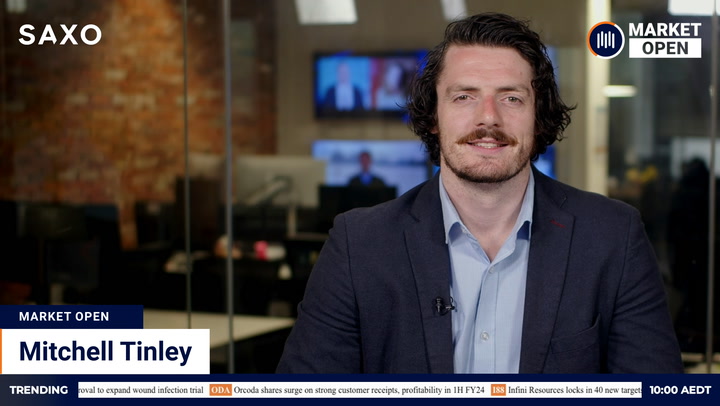A week-long rally in mining stocks ensured the ASX rose for the fourth time in five sessions, closing at a new peak.
Records for BHP and Rio Tinto helped propel the S&P/ASX 200 to a gain of 37 points or 0.5 per cent.
Support came from Woodside, Telstra and the banks. Tech stocks and bond proxies wilted in the face of rising bond yields.
What moved the market
The latest up-leg of the pandemic-era bull market has been all about the miners. The materials sector rallied 1.58 per cent today during a session when only one other sector made more than 1 per cent (energy +1.26 per cent).
The financial sector improved as the day wore on but has underperformed for a month as renewed lockdowns without the JobKeeper safety net raise the spectre of an upsurge in bad debts, and falling bond yields crimp margin opportunities. Since its pandemic-era peak on June 17, the financial sector has fallen almost 4.3 per cent. Materials have risen 8.5 per cent.
Iron ore prices have steadied this week after a sharp decline last week. Copper rose to a six-week high overnight after flooding hit central China.
“The recent boost in commodity prices led by copper appears to be driving gains for mining players,” Kalkine Group CEO Kunal Sawhney said. “Copper prices are going uphill on a strong demand outlook and supply constraints following floods in Henan province in central China, which is a major production hub for the commodity.”
The prospect of a bumper corporate earnings season helped the market shrug off more evidence of the economic impact of lockdowns. ANZ data indicated spending in Sydney slumped last week to its lowest level since the start of the pandemic.
Consumer confidence deteriorated to a 2021 low. The ANZ Roy Morgan weekly index declined 3.5 per cent from 104.3 to 100.7, a level last seen in November last year. Despite the decline, the index remained well above pandemic lows.
“The equity market seems to be looking past the recent surge in COVID-19 cases and resultant lockdowns, which have sparked concerns over Australia’s growth outlook,” Kalkine’s Mr Sawhney said.
“The profit season beginning this week appears to be deviating investors’ attention from economic concerns. One of the most interesting trends worth watching this reporting season will be whether rising input prices are impacting companies’ profit margins.”
The market pared its gains as US futures responded to further weakness in Asia following China’s intervention in education and property markets. S&P 500 futures declined nine points or 0.19 per cent.
The Shanghai Composite, which fell 2.34 per cent yesterday, dipped another 0.56 per cent. The Hang Seng compounded yesterday’s 4.13 per cent decline with a drop of 2.56 per cent. The Asia Dow gained 0.18 per cent. Japan’s Nikkei added 0.41 per cent.
Winners’ circle
Rio Tinto joined BHP at record levels, rising 1.81 per cent. BHP put on 2.79 per cent. Fortescue Metals added 1.57 per cent.
“A weaker [US dollar] amid record-low US real yields has stoked some exuberance within the base metals complex. [London Metal Exchange] copper broke above its 50-day moving average and settled more than 3% higher on the day, which may have triggered further systematic buying interest,” ING commodities strategists Wenyu Yao and Warren Patterson wrote.
“The Delta variant and rising Covid-19 cases have failed to show strong evidence of demand destruction,” they added.
Strength in copper prices and robust South Australian production helped lift OZ Minerals 6.53 per cent. Copper output increased 22 per cent last quarter despite the impact of Covid-19 on the miner’s Brazilian operations. The company reaffirmed its full-year copper production guidance, lifted gold guidance and reduced its cost outlook.
Energy was the session’s other standout sector despite a mixed performance on energy markets overnight. Woodside Petroleum climbed 1.86 per cent. Santos tacked on 1.39 per cent.
Oil Search eased 0.51 per cent after reporting a drop in production last quarter. Strong prices helped the company increase second-quarter operating revenue by 21.5 per cent despite a 4.1 per cent dip in output due to planned maintenance. The company reaffirmed its full-year guidance.
Bluescope rallied 6.4 per cent to an all-time high after beating second-half guidance. The steelmaker said it expected a record second-half contribution of $1.19 billion, above previous guidance of $1 – $1.08 billion. The strong half lifted full-year underlying earnings to $1.72 billion.
Temple & Webster tested six-month highs after reporting a record full-year result and a strong start to the new financial year. The online furniture retailer increased full-year revenue by 85 per cent to $326.3 million. Revenues during the first three weeks of this month improved 39 per cent from the same period last year. The share price jumped 7.41 per cent.
“While lockdowns during FY20 and FY21 have accelerated the underlying shift from offline to online, pleasingly we continue to see strong growth even when comparing against Covid impacted numbers,” CEO Mark Coulter said.
Japara Healthcare flew up 18.45 per cent to $1.38 after the board backed a deal for Calvary Health Care to acquire the company at $1.40 a share. The aged care provider had been the object of a bidding war between Calvary and Bolton Clarke. The board unanimously recommended the improved Calvary offer in the absence of a superior bid.
The banks overcame a mixed start. CBA gained 1.58 per cent, ANZ 0.87 per cent, NAB 0.15 per cent and Westpac 0.69 per cent
Doghouse
Rising bond yields dulled interest in traditional alternative investments. Healthcare, consumer staples and utilities all declined after the yield on ten-year Australian government bonds climbed a basis point back above 1.2 per cent.
Cochlear fell 1.9 per cent, Fisher & Paykel Healthcare 2.05 per cent and AGL Energy 2.03 per cent. At the heavyweight end, Woolworths eased 0.08 per cent, CSL 0.21 per cent and Transurban 0.28 per cent.
Tech – another yield-sensitive sector – declined 0.85 per cent. Nanosonics gave up 2.78 per cent, Appen 2.91 per cent and Afterpay 1.66 per cent.
Kina Securities slid 6.9 per cent after regulators in Papua New Guinea opposed the lender’s proposed acquisition of Westpac‘s Pacific businesses. The PNG Independent Consumer and Competition Commission issued a draft determination indicating it proposes to deny the sale. Westpac and Kina intend to make further submissions ahead of a final determination in September.
Other markets
Oil cemented an overnight advance. Brent crude rallied 27 US cents or 0.37 per cent to US$73.97 a barrel.
Gold extended its retreat below US$1,800 an ounce, declining US$5 or 0.28 per cent to US$1,794.20.
The dollar faded 0.17 per cent to 73.71 US cents.







